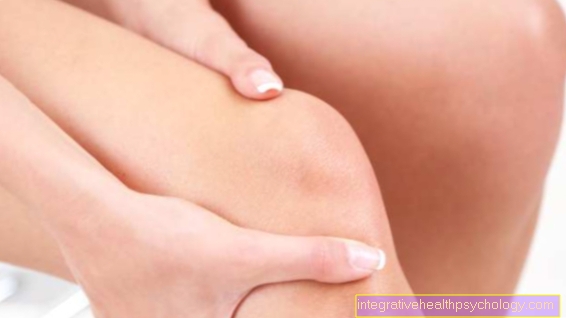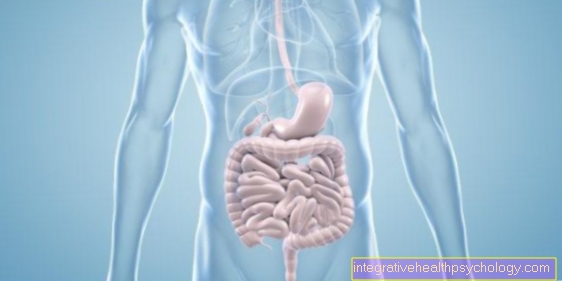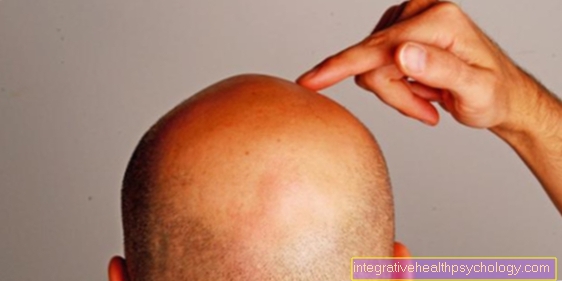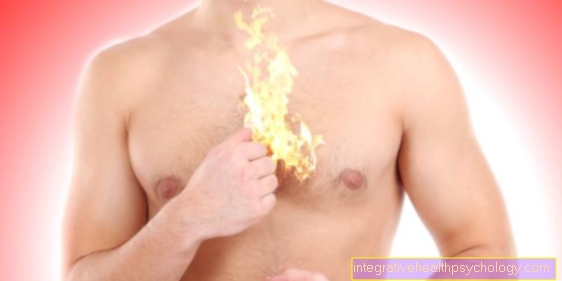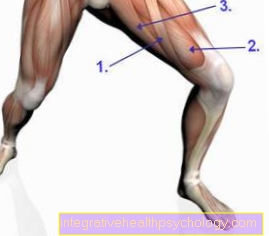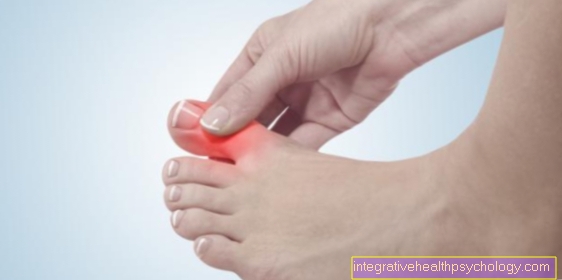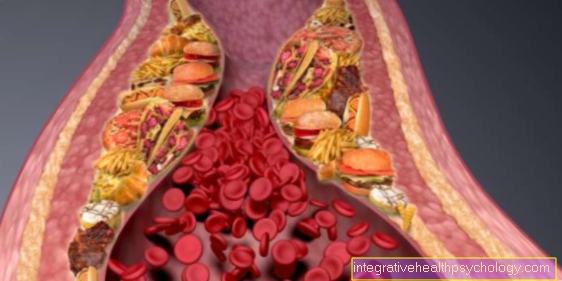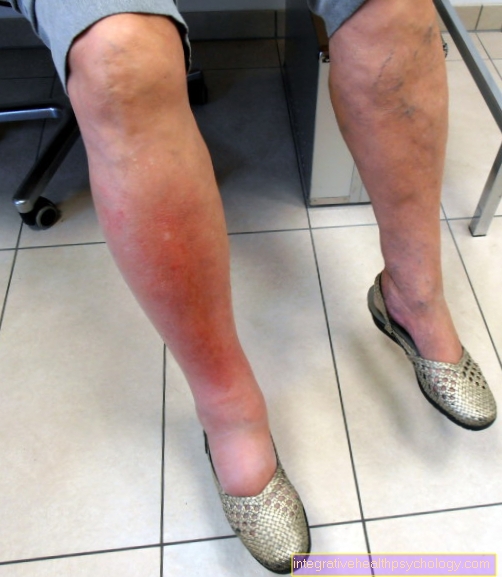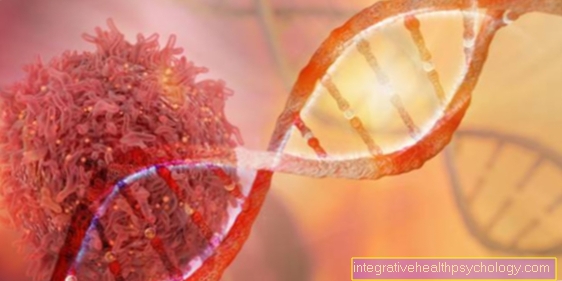Inflammation of the Armpit - How Dangerous Is It?
General
Inflammation that occurs in the armpit area can have a number of causes. In most cases, the inflammatory processes in the armpit are provoked by the slightest damage to the skin, through which bacterial pathogens can penetrate the surface of the skin.
This damage usually results from regular shaving and the use of antiperspirants (deodorants). Almost all men and women who shave their armpits at regular intervals can observe the appearance of skin irritations and small pimples. These look unsightly and can cause severe itching and burning, but are usually harmless and self-limiting. Ingrown hairs often appear after shaving, which are very similar to pimples and are therefore also known as "razor pimples". Look here: Ingrown armpit hair
Depending on how sensitive the armpit skin of the affected patient is, pronounced inflammatory processes can develop in addition to these skin irritations. For this reason, people with dry, flaky skin in particular should refrain from shaving and choose a different depilation method.

In addition, inflammation in the armpit area can originate from the numerous sweat glands within this area. In contrast to the skin irritation caused by shaving, sweat gland inflammation is not just an aesthetic, but above all a painful problem. If the armpit inflammation is particularly severe, any contact with the skin and / or clothing can be extremely painful.
There are approximately three million sweat glands on the human body. Most sit in the forehead, palms, soles and armpits area. Due to their anatomical structure, the sweat glands are divided into two groups: those that are free in the skin and those that are directly connected to a hair follicle. The sweat glands of the armpit are usually attached to a hair follicle due to the thick hair.
The main cause of inflammation of the sweat glands in the armpit area is the blockage of the sebum glands and the associated blockage of the sebum flow. Some risk factors have now been identified that are believed to increase the risk of underarm inflammation.
Read more on the subject at: Sweat gland inflammation
Risk of inflammation in the armpit
As a rule, inflammation in the armpit is a harmless local process, which in most cases occurs as a result of the smallest skin lesions. This often occurs during the depilation process when shaving or through the use of aggressive depilatory creams.
Pathogens can penetrate the skin through the small lesions and cause a limited inflammation that can be painful and reddened. This usually heals within a few days without any consequences. Only in rare cases does an abscess form, an encapsulated, purulent, inflammatory process that should definitely be inspected by a doctor and, if necessary, opened or treated with antibiotics.
However, if the pathogens penetrate the sweat or sebum glands of the armpit skin, they can trigger sebum congestion as part of the inflammation, which can promote the formation of an abscess.
In connection with hair removal, armpit hairs can also grow in, which can trigger long-term inflammation and usually manifest as itchy, painful and red pimples. These do not necessarily represent a reason to see a doctor, but should be observed.
Inflammation in the armpit is only a cause for concern in very rare exceptional cases, as it usually heals on its own. Only if the symptoms persist for more than a week, severe pain or the development of a relevant swelling, which can be indicative of the development of an abscess, should a doctor be consulted. As an abscess can lead to systemic spread of the pathogen, which can lead to serious complications.
Causes of inflammation of the armpit

The causes of inflammation in the armpit area are varied. In general, the skin of the armpit is one of the very sensitive areas of skin, as it is a hairy area of skin that contains a large number of sweat glands attached to hair follicles. Due to the constant production of sweat and the composition of the sweat, the armpit skin is heavily stressed. In addition, both the close skin contact with the upper arm and the clothing cause mechanical friction, which repeatedly removes the uppermost skin flakes. Most people also frequently apply antiperspirants, which increasingly irritate the skin of the armpit.
The most common causes of inflammation in the armpit area include regular use of a razor or other depilatory products. Especially when using a razor, not only the superficial parts of the hair are removed, but also the smallest skin injuries. Shaving without causing at least minor damage to the skin is often not possible or very difficult due to the anatomical design of the armpit. If the affected people develop a lot of sweat after the hair removal, this irritates the smallest wound edges and under certain circumstances leads to inflammation. Applying a deodorant immediately after shaving can worsen these skin reactions and increase the risk of inflammation. People who prefer this form of hair removal should change the blade of their razor regularly, because blunt razor blades in particular ensure that the hair is less cut off and rather torn from the skin. Inflammation in the armpit is more likely the less the razor blade is replaced. In addition, regular depilation of the armpits can cause the hair to grow in and spread below the surface of the skin. As a result, purulent inflammation can develop over time.
Another cause of inflammation in the armpit area is bacterial infection of the sweat glands (sweat gland inflammation). In most cases this is due to a cornification disorder of the uppermost skin layer, which leads to excessive callus formation and clogs the ducts of the sebum glands. Normally, sebum is regularly secreted through these ducts in order to keep the skin surface supple and protect it from drying out. The blockage of the excretory ducts causes sebum build-up in those affected, as a result of which bacterial pathogens can multiply unhindered in the area of the hair follicles of the armpit and cause inflammation. The typical bacterial pathogens causing inflammation in the armpit area are staphylococci.
If this inflammation persists over a longer period of time, increasingly purulent secretion is formed, which can cause the development of a skin abscess.
Read more on the topic: Clogged sebum - what to do?
Other factors that promote the development of inflammation in the armpit area are:
- Smoke
- Obesity (this leads to increased fluid secretion and the softening of the armpit skin)
- tight clothes
- Diabetes mellitus
- male sex hormones
- bacterial pathogens
The inflammation after a shave
The armpit is a sensitive area of skin that is particularly stressed when shaving. Inflammation in the armpit area is not uncommon and can have various causes. In the skin of the armpit, in addition to various glands, there are also hair follicles. When shaving, the hair on the surface of the skin is cut off. So the hair follicle is still in the skin. After shaving, the hair naturally grows back.
However, since it has a very sharp edge due to the shaving, it can grow in more easily and lead to inflammation. But what exactly is ingrown hair and what does it look like? Especially curly, thick, and unruly hair can grow in easily. The hair grows crooked and penetrates the skin instead of growing outward. It then continues to grow under the surface of the skin. This can also easily happen after shaving the armpit area.
The inflammation appears as a kind of "pimple" that itches, hurts and can be reddened. When pressure is applied, pus can also drain from the “pimple”. People who are prone to ingrown hairs should avoid shaving or epilating their armpits and of course other areas of the skin as well, and prefer to grow the skin. If you prefer to shave, you should treat the skin with a peeling beforehand. The hair should only be removed in the direction of growth.
After shaving, it is advisable to apply a moisturizing cream to the skin. An ingrown hair in the armpit area is initially not a reason for a doctor's visit, as long as it is not bothersome and the skin does not hurt. However, if the area is severely inflamed or an abscess has formed, a doctor must be consulted to remove the hair.
Shaving can also damage your skin, especially if the blade isn't really sharp. Injuries to the skin can cause germs to enter the body, which then lead to inflammation of the armpit. Such inflammation may also be painful or itchy, and swollen and red. In some cases, it is not the shaving itself that is to blame for the inflammation, but rather intolerance to the products used.
There may be incompatibilities, for example, with a deodorant or a shaving foam. Inflammations that occur in a temporal context to the use of a product are suspect. Furthermore, long-standing yeast infections with a yeast (Candida) can cause symptoms after shaving.
A fungal infection of the armpit often goes undetected by those affected for a long time or is dismissed as "inflammation after shaving" or something similar. Such a fungal infection is particularly common in summer when you sweat a lot. It manifests itself as itching and a ring-shaped, red rash, which can be quite extensive.
In addition, careful skin care should be taken after depilation. In order to reduce the risk of inflammation in the armpit area, a nourishing skin cream with an antibacterial effect should be applied urgently. One example is the Dr. Severin Body After Shave Balm from the pharmacy.
Occurrence through deodorant
Some ingredients in various deodorants lead to intolerance and inflammation in the armpit. For example, the fragrances but also preservatives and essential oils contained can lead to inflammation or allergic skin rashes.
If you are not sure whether a deodorant could be the cause of an inflammation in the armpit, it is advisable to simply leave it off for a few days. If there is improvement, a connection with the deodorant is not unlikely. A worsening of the inflammation when using the deodorant again strongly suggests that it is an intolerance. Well-tolerated deodorants usually contain no preservatives and are fragrance-free, but they lack the antiperspirant effect. So they only counteract the formation of odor, but cannot prevent sweating.
Antibacterial aftershave balms can also help disinfect and soothe the skin. This is especially true after hair removal. One example of this is the Dr. Severin Body After-Shave Balm from the pharmacy.
Figure causes an underarm inflammation

Inflammation of the armpit
- Pimples
(Pus vesicles, pustules)
in the armpit - Skin abscess
(with purulent secretion
filled cavity without
Execution course) - Sweat gland inflammation
- Abscesses
(Pus cavity inwards
emptied) - may lead to
Development of blood poisoning!
Causes:
A - regular use
a razor or other
Depilatories
B - deodorants
(after hair removal)
C - smoking
D - overweight
(increased fluid secretion)
Therapy:
E - anti-inflammatory ointments
(with ingredient marigold)
F - tar ointment -
to treat abscesses
(conservative) or operational
(open surgically)
You can find an overview of all Dr-Gumpert images at: medical illustrations
Symptoms of inflammation of the armpit

In most cases, inflammation in the armpit area causes the classic signs of inflammation (rubor, dolor, tumor, calor, functio laesa). The affected people already feel an increasing feeling of tension during the development of the inflammatory processes, which over time is perceived as slight to severe pain. Furthermore, the skin of the armpit shows a red color (reddening) if there is inflammation. Both holding the arm in the normal position and lifting the arm can cause severe pain for those affected; this is due to the friction that acts on the inflamed skin surface during these movements. Applying an antiperspirant can also lead to severe pain. People who suffer from inflammation in the armpit area usually notice a significant restriction in movement. In addition, inflammation of the armpit can show through the appearance of flaky, dry skin. Local swellings that arise on the affected skin areas are also a typical symptom of inflammation in the armpit. In addition, pronounced inflammatory processes can lead to itching and burning in those affected.
Also read our topic: Armpit pain
Formation of pus / abscess
A abscess is a collection of pus that results from tissue being placed under a inflammatory process melts down. This creates a kind of cavity in which the pus can collect. The armpit is a region that is often affected by an abscess. The causes of the formation of an abscess have not been conclusively clarified. The question of why some people are more likely to suffer from abscesses than others cannot be answered very clearly either.
Causes of abscesses can be the Entry of germs into the skin, ingrown hairs or inflammatory skin diseases such as a Acne inversa be. Also an inflammation of the hair follicle, a so-called Furunculosis, can lead to the formation of an abscess in the armpit. The abscess causes pain and reddening of the skin. Overheating is also typical.
The skin in the armpit can appear tight and shiny. You shouldn't try to open the abscess yourself, but rather consult a doctor immediately. Otherwise, an abscess can become a dangerous one Blood poisoning (sepsis) and must therefore be surgically opened and rinsed.
Complications
The most common complication of inflammation in the armpit area is the emergence of one Skin abscess. An abscess is one Cavity filled with purulent secretion without an outlet duct, which could ensure a proper drainage of the secretion. In addition to the purulent secretion, there are various inside the abscess Inflammation mediators, which further promote the inflammatory processes. Inflammation in the armpit area tends to develop a skin abscess, especially if that immune system of the affected patient weakened is. You can also previous surgical interventions promote the formation of a skin abscess in the armpit in this skin area.
Furthermore, there is an abscess of the armpit dangerthat the Pus cavity emptied inwards. If this happens, the bacterial pathogens can get into the bloodstream and cause a Blood poisoning (sepsis) to lead. Blood poisoning is potentially life threatening Illness that requires urgent medical treatment.
Therapy for inflammation of the armpit

Treating inflammation in the armpit is always based on the underlying problem.
If the inflammatory processes are caused by the respective depilation method, this should be reconsidered. Some people tolerate depilation with wax or an epilator in the armpit area much better than a daily shave. However, as these procedures can be very painful, special depilatory creams can be used as an alternative. However, these should be tested on a small area of skin before the actual application. If redness develops during this test, the depilatory must never be used in the armpit area. In addition, when using depilatory cream, you should urgently adhere to the exposure times recommended on the package insert. Otherwise it can lead to painful skin symptoms and local inflammatory reactions, as the strong chemicals contained in depilatory creams cause the hair to dissolve. If these chemicals act on the surface of the skin for too long, the individual skin cells can be severely damaged. In addition, careful skin care should be taken after depilation. To reduce the risk of inflammation in the armpit area, a nourishing skin cream should be applied urgently.
In addition, there is a possibility that the inflammation of the armpit is caused by cosmetics. If this is suspected, those affected should consider changing the care products used. In general, products that contain alcohol should be avoided, as they disinfect the surface of the skin, but at the same time ensure that it dries out and becomes cracked. The use of alcohol-based care products and / or deodorants can lead to severe pain and burning sensation in the armpit area if there is inflammation. In addition, the various fragrances contained in the individual care products can cause inflammatory processes or slow down the healing of inflammations. People who observe skin reactions immediately after applying such care products should, under certain circumstances, consult a dermatologist and have their intolerance determined. Even in such cases, simply changing creams and / or deodorants can help relieve the inflammation of the armpit.
At severe pain or the presence of particularly pronounced symptoms locally effective, anti-inflammatory ointments to be applied to the armpit. Especially ointments that contain the ingredient "Marigold“Contain, are useful for treating inflammation of the armpit. The persons concerned should in any case note that at inflamed pimples in the armpit area never manipulated independently should be; it may be a Cornification disorder act with excessive sebum production. The pushing around would be too in this case extensive inflammatory reactions lead and make the situation worse.
Are in the area of the inflamed armpit rounded swellings to recognize the severe pain that is causing it should be an urgent one Specialist to be visited. This type of swelling could possibly be one abscess act that needs urgent treatment. Treatment for inflammation-related abscesses in the armpit can be both conservative (non-surgical), as well operational respectively. In many cases it is sufficient for a period of several days a tar-containing ointment to apply. This measure can lead to a regression of the purulent processes. There is also a possibility of an inflammation-induced abscess in the armpit to open surgically and in this way the Drainage of the pus to guarantee.
What can you do about the pain?
The pain associated with inflammation of the armpit can be treated with pain reliever medication, which is either prescribed by a doctor or available over the counter at the pharmacy. Let yourself be carried away by Your doctor to advise. Examples of such drugs, which also have anti-inflammatory effects at the same time, are ibuprofen, aspirin or diclofenac.
However, they are not suitable for long-term use and should not be taken for more than a few days. Also warming and moist compresses can help against the pain. Simply press it gently against your armpit. Furthermore, make sure not to strain the stressed skin by shaving or clothing that is too tight. In the case of severe pain, exercise should also be avoided until the inflammation has improved.
Creams and pull ointments
Using cooling creams with antibacterial ingredients can help with certain inflammations. Most of the time, however, they are not necessary. Light cortisone ointments can be used for allergic rashes and inflammation.
As a rule, however, creams and ointments play a subordinate role in the treatment of inflammation of the armpit, since usually no therapeutic measures are necessary. In the case of an abscess, adequate therapy is required that does not include the use of creams or a pulling ointment. Pull ointments, which are supposed to promote blood circulation and facilitate the opening of an abscess, are highly controversial and are therefore rarely used.
Home remedies
Inflammation in the armpit can be very uncomfortable for those affected. Pain and itching are possible symptoms and redness or swelling can also be very annoying. Some infections, such as abscesses, require medical attention. In the case of milder inflammation, for example after a shave, home remedies can also help to alleviate the symptoms initially. The following section lists some tips and tricks you can use to relieve inflammation in the armpit area.
- Take care of the skin !: In the event of inflammation, very tight clothing in the armpit area should be avoided. Furthermore, scratchy and irritating textiles such as lambswool should be avoided. If you suspect a textile intolerance, you should avoid these textiles. Washing with fabric softener or irritating detergents should also be avoided.
- Avoid irritating deodorants and care products! : It is advisable to leave out the deodorant that is usually used to find out whether the inflammation may be related to it. Use fragrance-free deodorants and soaps. Natural deodorants such as alum or lemon juice can also be used.
- Apply warm compresses !: Warm, moist compresses can alleviate the symptoms of inflammation and encourage the outflow of inflammatory fluid in the affected area. However, always use clean compresses (washcloths) and therefore change them after each application.
- Apply soothing oils !: Aloe vera or tea tree oil are suitable for this. However, pay attention to your skin's reaction. Some people may also have intolerance to essential oils.
Lump in the armpit
Lumps in the armpit area can have various causes - both benign and malignant causes are possible. Should you feel a lump in the armpit, a visit to the doctor is advisableto clarify the cause. In many cases, a simple infection with a virus is the cause of the lump. Infections with Ebstein-Barr virus can also lead to lumps in the armpit area. The nodes are Lymph nodeswhich swell as part of the immune response. Typically, the lymph nodes become painful when pressure is applied to them.
Another common and benign cause of armpit lumps is Furunculoses, which are painful inflammations of the hair follicle. Unfortunately, malignant diseases of the blood, lymphatic system and various organs can also lead to the formation of lumps in the armpit. Such nodes are also swollen lymph nodes.
Mostly they are not painful and, unlike infectious diseases, they are not reddened either. Malignant diseases of the lymphatic system such as lymphoma are Concomitant symptoms such as fever, night sweats and a weight loss are typical. Swollen lymph nodes in the armpit are a possible indication of breast cancer in the affected side for women. However must expressly It should be emphasized that malignant diseases such as cancer are the far less common cause of lumps in the armpit area than benign diseases such as viral infections.
Occurrence during pregnancy
Inflammation of the armpit is also possible during pregnancy. In principle: The same causes can occur during pregnancy, for example minor injuries in the shave, Abscesses or Inflammation of the hair folliclesto be responsible for the inflammation in the armpit.
Painful swollen lymph nodes can also indicate a viral infection during pregnancy, but this is not necessarily a cause for concern. Inflammation in the breast area, especially at the end of pregnancy and while breastfeeding, can lead to inflammation and swelling in the armpit area.
Most of the time, these are also swollen armpit lymph nodes. If you experience pain and inflammation in the armpit, you should start off as a pregnant woman Quiet Preserve: Usually it is a harmless cause such as a slight inflammation from shaving. Nevertheless, you should visit your gynecologist and examine the inflamed or swollen area and seek advice.
For more information, see the following article: Infections in pregnancy
Occurrence in the baby
Many parents see their babies develop inflammation in the armpit. Usually this appears as reddening, which is accompanied by yellowish flaking or a kind of "sour cream", as many parents call it. As a rule, this is the harmless "Head gneiss“, Which is very common within the first three months occurs in babies and disappears by the first year of life.
The head gneiss needs no special therapy. Often there is slight redness in the armpit after bathing. Slight itching is also possible. You can avoid this by taking care to dry the baby's skin folds well, for example in the groin and armpit. A little baby powder can also help. A wound healing ointment can also help reduce the redness.
Get advice from your pediatrician and show him the inflamed areas as soon as possible. However, such redness usually goes away in babies quickly and without complications. If itching and reddening persists beyond the third month of life and does not respond to measures such as drying off well and the use of wound healing ointment and baby powder, one can also Neurodermatitis be considered as the cause.
Further topics from this area

Abscess of the axilla
An abscess is a cavity filled with pus. Abscess formation can arise in the course of inflammatory processes.
Here you get to the topic: abscess of the axilla

Skin itches after shaving
After shaving, itching may occur, accompanied by redness, swelling and often small pimples. This skin condition is also known as razor burn.
Here you get to the topic: Skin itches after shaving

Homeopathy for skin inflammation
Inflammation of the skin is often accompanied by redness, swelling and pain. Homeopathic remedies can also be used to treat inflammatory processes.
Here you get to the topic: Homeopathy for skin inflammation






